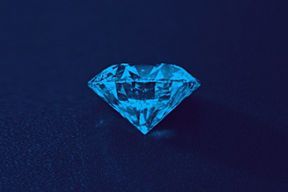What is fluorescence in a diamond?
As one of the lesser-known characteristics of a diamond, fluorescence is commonly misunderstood. In reality, diamond fluorescence is a simple, natural effect appearing in roughly 30% of all diamonds that causes them to glow under ultraviolet light (UV). Diamond fluorescence is most often blue, but it can manifest in a wide array of colors including yellow, orange, red, white or green.
In a small percentage of diamonds (less than .02%), fluorescence can give the stone a cloudy or oily look, and some consider this to be an undesirable trait. In other cases, fluorescence can give certain diamonds on the color spectrum a whiter appearance, which is perceived as a positive. That’s why it takes a little more digging to understand if strong fluorescence in a diamond is good or bad.

Diamond Fluorescence Scale And Ratings
The Gemological Institute of America (GIA) does not factor in diamond fluorescence to determine quality, like it does with the diamond 4Cs – color, cut, clarity, and carat. Instead, the GIA uses fluorescence as an identifying characteristic that aids in distinguishing one stone from another. GIA grading reports label the intensity of diamond fluorescence as follows:
• None: No glow at all under a UV light.
• Faint: Very light glow under a UV light.
• Medium: A glow is prevalent under a UV light.
• Strong or Very Strong: A profound glow is clearly seen under a UV light.
How To Use Diamond Fluorescence To Your Advantage
Higher Grade. Lower Price.
Color, which is one of the 4Cs, is utilized by gemologists to help determine the quality of a diamond. On the high end of the color spectrum are colorless diamonds labeled D-F. When a diamond in the color range of D-F has Strong to Very Strong fluorescence it’s not uncommon to see discounted pricing. This happens because many people automatically assume that a high fluorescence rating means that a diamond will have a hazy or oily appearance. And though this effect is rare, this negative association can still decrease a diamond’s perceived value.
Fluorescence And Diamond Color
Interestingly, fluorescence can give the perception of improved color to diamonds in the color range of H-K. Diamonds that fall in this range often contain a faint yellow hue, and when counteracted by a Medium or Strong blue fluorescence, the combination can help make them look whiter.
GIA Ratings And Evaluation Of Fluorescence In Diamonds
All Blue Nile loose diamonds have been analyzed and graded for quality by the GIA, one of the most respected and accurate labs in the diamond industry. That’s why, given the controversy around this characteristic, it’s probably best to take advice on diamond fluorescence directly from the GIA:
“GIA studies show that for the overwhelming majority of diamonds, the strength of fluorescence has no widely noticeable effect on appearance. In the GIA Fluorescence Study, it was found that the average person could not make a distinction between a diamond with fluorescence and a diamond without. In many instances, observers prefer the appearance of diamonds that have Medium to Strong fluorescence. In rare cases, some diamonds with extremely strong fluorescence may appear hazy or oily; fewer than 0.2% of the fluorescent diamonds submitted to GIA exhibit this effect."
In addition, Live Chat is available during most business hours.
Diamond Fluorescence FAQs
What does diamond fluorescence mean?
For diamonds and gems, fluorescence means that they emit a glow under UV light.
Do diamonds glow under UV light?
No, very few diamonds will fluoresce or glow under UV light. It’s estimated that around 30% of diamonds have this UV glow.
What color can diamond fluorescence be?
Fluorescence in diamonds is typically blue. But diamond fluorescence is also possible in other colors such as yellow, orange, white, green or red.
Is diamond fluorescence a good thing?
There are many schools of thought regarding fluorescence. Overall, it is neutral for diamonds – neither good nor bad. On the positive side of things, fluorescence can make a stone more affordable, and it is generally imperceptible. On the negative side, a strongly fluorescent diamond may have an oily appearance in natural lighting settings.
The GIA rating regarding a stone’s fluorescence will help identify the presence and intensity of the fluorescent phenomenon. Detailed diamond photos and multiple viewpoints, along with the other components of the gem’s 4Cs, will help identify whether or not fluorescence impacts its other qualities. Because fluorescence only occurs in roughly 30% of all diamonds, it is a unique feature that many people enjoy.
How do I know if my diamond is fluorescent?
To test whether your diamond has fluorescence, simply put the gemstone under a UV light to see if it glows. When diamonds under UV light glow, they have fluorescence. If you are curious whether a diamond you are looking to purchase has fluorescence, check the gemstone’s GIA report or check with the jeweler.
What causes diamond fluorescence?
Diamonds with trace amounts of other elements, such as boron or nitrogen, may have fluorescence.
Should I buy a diamond that has fluorescence?
Diamond fluorescence is one of the many qualities that affect a diamond’s appearance and value. Fluorescence is not necessarily a bad thing for diamonds and many people enjoy this unique feature. If you are considering a diamond with fluorescence, review its full GIA report to see how the gemstone’s glow impacts its 4Cs. It is very rare for fluorescence to impact a diamond’s visual appearance or its structural integrity.
Should I be worried about diamond fluorescence?
Because fluorescence is generally neither good nor bad for diamonds, it is typically not something you should worry about. If you don’t want any UV glow in your diamond, choose one that the GIA has rated as having no fluorescence. If you are looking to purchase a more affordable diamond or one with this unique characteristic, consider diamonds rated higher on the fluorescence GIA scale. It’s rare for diamond fluorescence to impact the stone’s structural integrity or appearance.